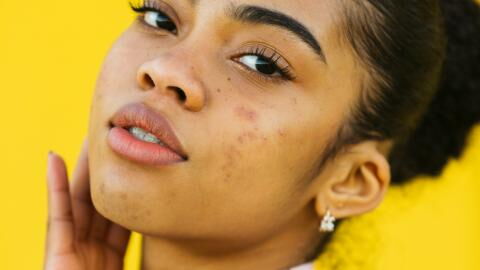Acne is no joke, and it’s something that we most of us have experienced at least once, but despite it being so common, it can be hard totreat acne effectively.
Discover our latest podcast
Rushing to apply astringent toners, essential oils and stripping masks can even damage the skin’s moisture barrier, making your acne worse. Instead, having a little patience and recognising precisely which of the six types of acne you’re experiencing will help you find the best treatment.
What causes acne?
Four factors are generally agreed to cause acne:
- An overproduction of sebum
- Dead skin cells
- P. acnes bacteria
- Inflammation
A pimple forms when sebum - the skin’s natural oil - and dead skin cells get trapped inside the pores; this creates the perfect environment for P. acnes bacteria to multiply, causing inflammation, resulting in that dreaded tender, red or pink bump on the skin.
Acne can occur almost anywhere on the body. Still, it mostly takes residence on the most exposed areas - our faces, shoulders and even upper backs, as these areas have the highest concentration of sebaceous glands.
Acne-causing factors can also be influenced by hormones, lifestyle, underlying health conditions and even medication. These conditions can make acne even harder to treat and often require professional solutions.
Different types of acne
While the same four factors cause all acne, there are six different ways that acne can present itself on the skin. These six different types of acne are either non-inflammatory or inflammatory, and each requires a different treatment approach.
Non-inflammatory acne
Non-inflammatory acne is caused by the clogging of the pores. However, there is often little p.acnes bacteria or inflammation, leading to tiny spots that don’t swell up like a classic pimple.
Blackheads
If you’ve ever gone out and purchased a charcoal pore strip, you probably pretty familiar with blackheads. This acne is caused when the pore becomes clogged with dead skin cells and sebum, but the pore stays open. The top layer of the clogged pore then becomes oxidised, leading to its ionic black top.
Whiteheads
Whiteheads are formed in the same way as blackheads, except with whiteheads, the pores do close up, leading to a small, white bump protruding from the skin.
To treat blackheads and whiteheads, use skincare ingredients such as salicylic acid, niacinamide, glycolic acid and lactic acid.

Inflammatory acne
Inflammation is usually caused by the body’s immune system trying to fight off a perceived threat. In the case of inflammatory acne, the danger is acne-causing bacteria. Inflammatory acne is formed when P.acnes bacteria makes itself at home in a clogged pore, triggering the immune system to flare up in the affected area. Inflammatory acne is usually characterised by red, swollen bumps that are often larger and painful to the touch.
Papules
Papules occur when the pores become so clogged with sebum and dead skin cells that their walls break down. This causes an inflammatory response, with white blood cells crowding the affected pore and forming pus to fight off bacteria. This combination of events results in a painful red bump on the skin that doesn’t show any whiteness.
Pustules
Often mistaken as whiteheads, pustules typically occur a few days after a papule has sprung. When the pocket of pus inside a papule has risen to the surface, it then becomes a pustule.
Papules and pustules are some of the most tempting types of acne to pop, but we wouldn’t recommend doing that. Popping your acne could irritate the skin and cause further inflammation and scarring, and can even increase the chances of infection. However, if your pustules do pop, try using an acne patch over them to create a protective layer and absorb any liquids.
Papules and pustules are a mild form of acne and can often be treated with salicylic acid and benzoyl peroxide. These ingredients often come in the form of cleansers, spot treatments, creams and toners, making it easy to incorporate them into your skincare routine.
Nodules
Nodules occur when clogged pores become so inflamed that they break down the walls of multiple follicles, and the pus, bacteria, debris and inflammation become a giant pimple. Nodules are much like papules, except that they are much bigger and often occur deeper under the skin, making them hard to treat with OTC products.
Cysts
Cystic acneoccurs even deeper under the skin than nodules and is larger still. These large, red lumps are filled with pus that has nowhere to go. Cystic acne is usually caused by a severe infection deep inside the pore and becomes more painful as it gets more inflamed or ruptures.
Nodules and cysts don’t always come to a head and are notoriously the most challenging types of acne to treat and the most likely to scar. The inflammatory response in nodules and cysts also take a long time to fade out and often will recur again in the same place.
Underlying hormonal conditions often trigger cysts and nodules; to treat them, it is essential to make an appointment with a doctor or dermatologist to figure out the source of the problem. These healthcare professionals will also prescribe treatments such as birth control, retinoids and antibiotics that can resolve the infection and reduce potential scarring.















